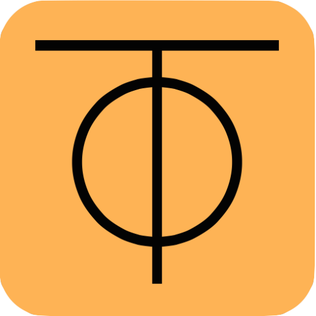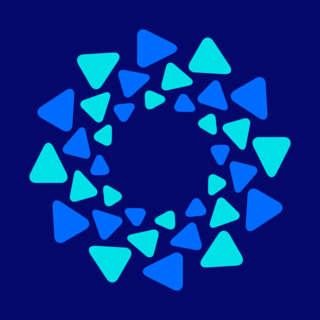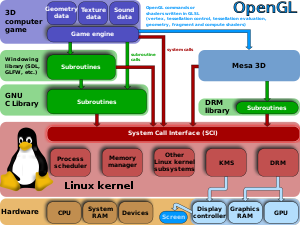
Simple DirectMedia Layer (SDL) is a cross-platform software development library designed to provide a hardware abstraction layer for computer multimedia hardware components. Software developers can use it to write high-performance computer games and other multimedia applications that can run on many operating systems such as Android, iOS, Linux, macOS, and Windows.

Wine is a free and open-source compatibility layer to allow application software and computer games developed for Microsoft Windows to run on Unix-like operating systems. Developers can compile Windows applications against WineLib to help port them to Unix-like systems. Wine is predominantly written using black-box testing reverse-engineering, to avoid copyright issues. No code emulation or virtualization occurs. Wine is primarily developed for Linux and macOS.

DTrace is a comprehensive dynamic tracing framework originally created by Sun Microsystems for troubleshooting kernel and application problems on production systems in real time. Originally developed for Solaris, it has since been released under the free Common Development and Distribution License (CDDL) in OpenSolaris and its descendant illumos, and has been ported to several other Unix-like systems.

Phoronix Test Suite (PTS) is a free and open-source benchmark software for Linux and other operating systems. The Phoronix Test Suite, developed by Michael Larabel and Matthew Tippett, has been endorsed by sites such as Linux.com, LinuxPlanet, and Softpedia.
Video Decode and Presentation API for Unix (VDPAU) is a royalty-free application programming interface (API) as well as its implementation as free and open-source library distributed under the MIT License. VDPAU is also supported by Nvidia.

Simple and Fast Multimedia Library (SFML) is a cross-platform software development library designed to provide a simple application programming interface (API) to various multimedia components in computers. It is written in C++ with bindings available for Ada, C, Crystal, D, Euphoria, Go, Java, Julia, .NET, Nim, OCaml, Python, Ruby, and Rust. Experimental mobile ports were made available for Android and iOS with the release of SFML 2.2.

DynamoRIO is a BSD-licensed dynamic binary instrumentation framework for the development of dynamic program analysis tools. DynamoRIO targets user space applications under the Android, Linux, and Windows operating systems running on the AArch32, IA-32, and x86-64 instruction set architectures.
MonoGame is a free and open source C# framework used by game developers to make games for multiple platforms and other systems. It is also used to make Windows and Windows Phone games run on other systems. It supports iOS, Android, macOS, tvOS, Linux, PlayStation 4, PlayStation 5, PlayStation Vita, Xbox One and Nintendo Switch. It implements the Microsoft XNA 4 application programming interface (API). It has been used for several games, including Bastion, Celeste,Fez, and Stardew Valley.
libGDX is a free and open-source game-development application framework written in the Java programming language with some C and C++ components for performance dependent code. It allows for the development of desktop and mobile games by using the same code base. It is cross-platform, supporting Windows, Linux, Mac OS X, Android, iOS, BlackBerry and web browsers with WebGL support.
CodeXL was an open-source software development tool suite which included a GPU debugger, a GPU profiler, a CPU profiler, a graphics frame analyzer and a static shader/kernel analyzer.

RPCS3 is a free and open-source video game console emulator and debugger for the Sony PlayStation 3 that runs on Windows, Linux, FreeBSD and macOS operating systems, allowing PlayStation 3 games and software to be played and debugged on a personal computer. It is being developed in the C++ programming language targeting x86-64 CPUs and features OpenGL and Vulkan as its backend renderers.
Vulkan is a low-level low-overhead, cross-platform API and open standard for 3D graphics and computing. It was originally developed as Mantle by AMD, but was later given to Khronos Group. It was intended to address the shortcomings of OpenGL, and allow developers more control over the GPU. It is designed to support a wide variety of GPUs, CPUs and operating systems, it is also designed to work with modern multi-core CPUs.

DBeaver is a SQL client software application and a database administration tool. For relational databases it uses the JDBC application programming interface (API) to interact with databases via a JDBC driver. For other databases (NoSQL) it uses proprietary database drivers. It provides an editor that supports code completion and syntax highlighting. It provides a plug-in architecture that allows users to modify much of the application's behavior to provide database-specific functionality or features that are database-independent. This is a desktop application written in Java and based on Eclipse platform.

ZeroTier, Inc. is a software company with a freemium business model based in Irvine, California. ZeroTier provides proprietary software, SDKs and commercial products and services to create and manage virtual software-defined networks. The company's flagship end-user product ZeroTier One is a client application that enables devices such as PCs, phones, servers and embedded devices to securely connect to peer-to-peer virtual networks.
Microsoft, a technology company historically known for its opposition to the open source software paradigm, turned to embrace the approach in the 2010s. From the 1970s through 2000s under CEOs Bill Gates and Steve Ballmer, Microsoft viewed the community creation and sharing of communal code, later to be known as free and open source software, as a threat to its business, and both executives spoke negatively against it. In the 2010s, as the industry turned towards cloud, embedded, and mobile computing—technologies powered by open source advances—CEO Satya Nadella led Microsoft towards open source adoption although Microsoft's traditional Windows business continued to grow throughout this period generating revenues of 26.8 billion in the third quarter of 2018, while Microsoft's Azure cloud revenues nearly doubled.

Raylib is a cross-platform open-source software development library. The library was made to create graphical applications and games.

ProcDump is a command-line application used for monitoring an application for CPU spikes and creating crash dumps during a spike. The crash dumps can then be used by an administrator or software developer to determine the cause of the spike. ProcDump supports monitoring of hung windows and unhandled exceptions. It can also create dumps based on the values of system performance counters.

Fyne is a free and open-source cross-platform widget toolkit for creating graphical user interfaces (GUIs) across desktop and mobile platforms. Fyne uses OpenGL to provide cross-platform graphics. It is inspired by the principles of Material Design to create applications that look and behave consistently across all platforms. It is licensed under the terms of the 3-clause BSD License, supporting the creation of free and proprietary applications. In December 2019 Fyne became the most popular GUI toolkit for Go, by GitHub star count and in early February 2020 it was trending as #1 project in GitHub trending ranks.

OneFuzz is a cross-platform free and open source fuzz testing framework by Microsoft. The software enables continuous developer-driven fuzz testing to identify weaknesses in computer software prior to release.













